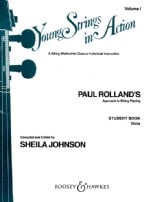Rolland, Paul (Paul Rolland/Sheila Johnson) - Young Strings In Action 1 (Viola)
A landmark in group teaching pedagogy developed by the highly acclaimed teachers Paul Rolland and Sheila Johnson. The fundamentals of string playing for group and individual teaching, for the first few years of learning. Young Strings in Action is a two-volume course in the fundamentals of string playing. Specifically designed for heterogeneous instrument classes, it has proven to be very successful in public school string programs. It is also intended for private as well as self instruction. Its two volumes, covering the first two years of instruction, constitute a complete manual of new ideas and proven techniques, enabling teachers to present in clear and concise terms the basic musical and technical skills necessary to play a violin, viola, cello, or bass. The well-tested approach to string playing offers all students a unique opportunity to progress quickly, while at the same time strengthening and refining the basic fundamentals. The student does more than simply play a string instrument: he or she develops a clear understanding of "how" to play. The material presented in these volumes is set forth in a format which allows flexible adaptation to a wide variety of classroom conditions, such as varying class size and instrumentation. In the student books for the four instruments, many of the repertoire pieces are presented in duet and trio arrangements, enabling performance by ensembles of like instruments, as well as various other combinations. Volume 1 emphasizes total body movement and left arm mobility, helping students to acquire freedom of movement, correct positioning and playing facility. The all-important position and balance of the left hand is aided by early emphasis on the central fingers and their relation to the adjacent string. Better intonation and hand position are achieved by emphasizing interval and chord relationships. A balanced bow arm is achieved by starting students at the middle of the bow. In Volume 2, the student develops flexible finger movements and is introduced to the positions most often used in the left hand fingering technique of each of the instruments. Refining the bow arm is also emphasized, using more complicated bowing patterns in the exercises and pieces, as well as groups of slurred notes and slurred string crossing.

